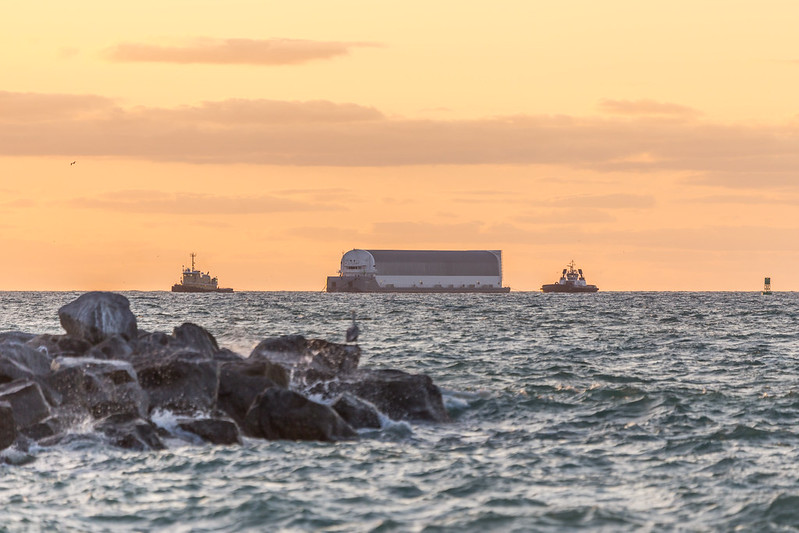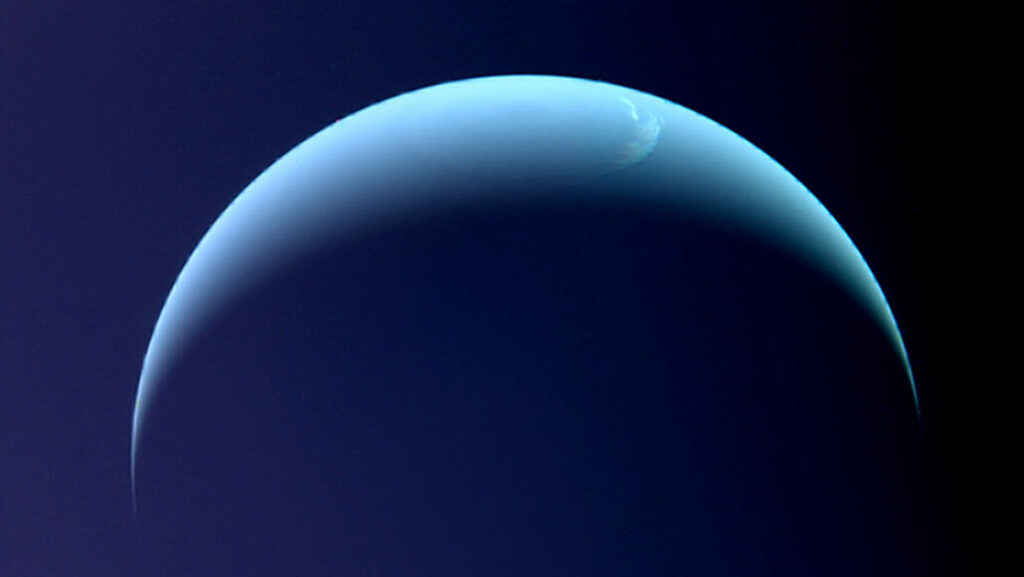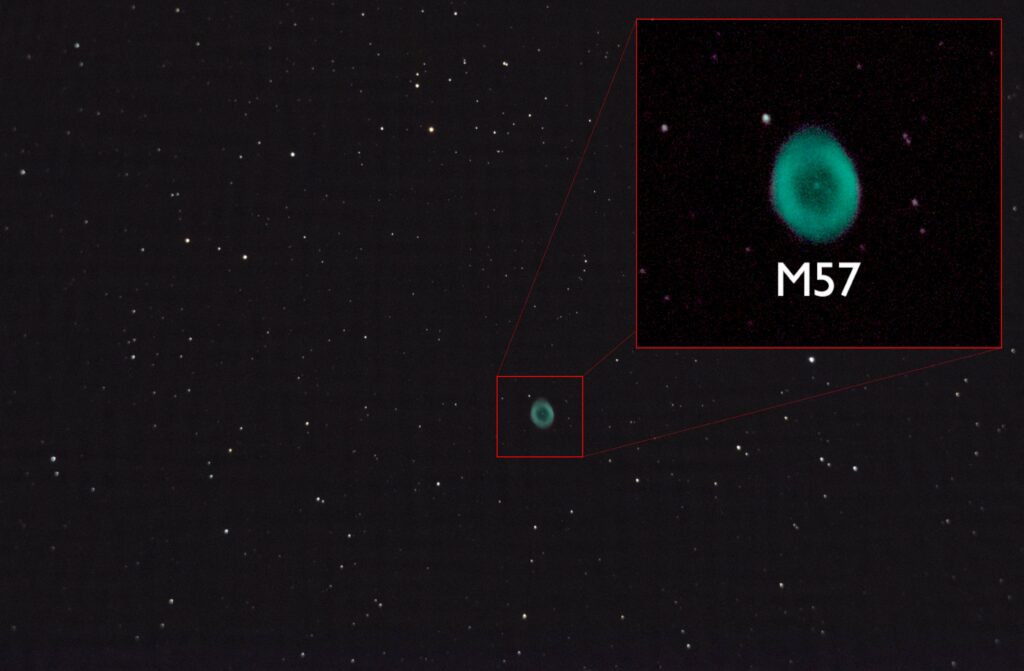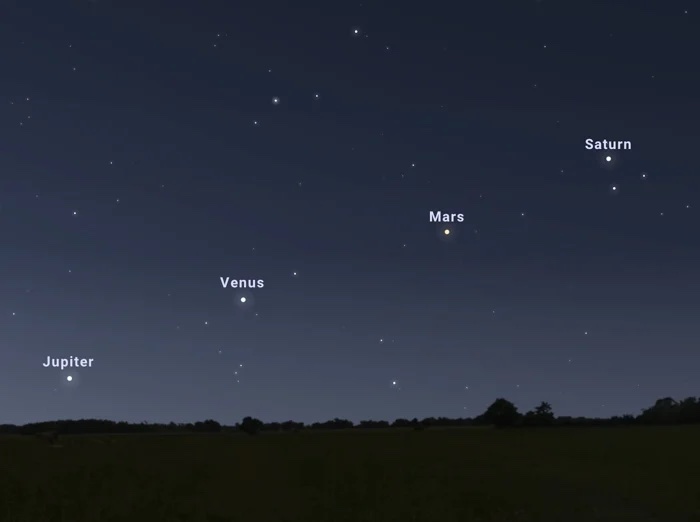An analysis of microscopic features in rocks from the Nuvvuagittuq Supracrustal Belt in Quebec, Canada, which date back between 3.75 and 4.28 billion years, finds evidence of possible microbial life. Plus, a supermassive black hole precursor, temperatures on Neptune, check-ins with various spacecraft, and our weekly What’s Up segment.
Podcast
Show Notes
Life started earlier than thought
- UCL press release
- “Metabolically diverse primordial microbial communities in Earth’s oldest seafloor-hydrothermal jasper,” Dominic Papineau et al., 2022 April 13, Science Advances
- “Evidence for early life in Earth’s oldest hydrothermal vent precipitates,” Matthew S. Dodd et al., 2017 March 2, Nature
Galaxy builds stars and black holes
- ESA Hubble press release
- Hubblesite press release
- NAOJ press release
- Subaru Telescope press release
- “A dusty compact object bridging galaxies and quasars at cosmic dawn,” S. Fujimoto et al., 2022 April 13, Nature
ULA gets Starliner help from unusual source
- ULA press release
Neptune’s temperature out of whack
- New thermal maps of Neptune reveal surprising temperature swings (Science News)
- “Subseasonal Variation in Neptune’s Mid-infrared Emission,” Michael T. Roman et al., 2022 April 11, The Planetary Science Journal
NASA and UAE collaborate on martian atmosphere science
- NASA Goddard press release
Lucy cameras working as expected
- NASA Goddard press release
MIRI instrument on JWST cooled to operating temperature
- NASA press release
- Webb’s Mid-Infrared Instrument Cooldown Continues (NASA)
What’s Up: Space events the week of April 18 onward
- 2022 Lyrid meteor shower: All you need to know (EarthSky)
- A Rare Planetary Alignment Is About to Happen. Here’s How You Can See It (Science Alert)
- Tau Herculid meteors in May might be intense! (EarthSky)
Transcript
We have all the normal suspects in today’s show: galaxies, early life, and even some good news about international cooperation in space.
And a large rocket in a ship made for a bigger one, to help Boeing’s Starliner go to space on time.
And Neptune’s atmosphere is surprising us. We really need to send a mission there.
In this week’s what’s up, we have another meteor shower and some planetary antics.
All of this and more, right here on the Daily Space.
I am your host Dr. Pamela Gay.
And I am your host Erik Madaus.
And we’re here to put science in your brain.

There are certain fundamental questions that most of us ask at one or more points in our life. One of the questions – how did life begin – is a science-spanning question that requires chemistry, biology, geology, and planetary science to begin to approach, and as we get better at working together to study our solar system, the possible story of life is getting more and more interesting.
Trying to understand the earliest periods of our world’s history is complicated by the lack of ancient land preserved in our current landscape. Only a couple of places retain relics of the most distant past. One of those regions is Quebec’s Nuvvuagittuq Supracrustal Belt (NSB). This band of rock was once part of an ancient seafloor located near hydrothermal vents. In the modern ocean, we find life clinging to the sides of similar vents that release heat and various nutrients. This is life that requires no sunlight and thrives in its own deepwater ecosystem.
The rocks in the Nuvvuagittuq Supracrustal Belt are between 3.75 and 4.28 billion years old, and researchers have gone fossil hunting in these rocks. Researchers sliced a fist-sized rock into narrow slices and scanned them with microscopes to look for signs of biological structures. While many of the “possible bacterial life” they found – things that looked like tubes, filaments, and ellipsoids – could also be the result of chemical reactions, they also found what they describe as “a stem with parallel branches on one side that is nearly a centimeter long.” Researchers have not found a way to explain this stem except as life.
These results are published in Science Advances in a paper led by Dominic Papineau, who explains: Using many different lines of evidence, our study strongly suggests a number of different types of bacteria existed on Earth between 3.75 and 4.28 billion years ago. This means life could have begun as little as 300 million years after Earth formed. In geological terms, this is quick – about one spin of the Sun around the galaxy.
Let’s take that conclusion and look more broadly at our solar system. This result implies life can form very quickly once a world starts to solidify and cool. Evidence points to both Venus and Mars having vast oceans early in their history. There is also the tantalizing possibility that Europa has this kind of deep ocean vent today. We have no idea if life forms easily or if it was an impossibly improbable event that started life on Earth. If life does form easily, we can look forward to potentially seeing similar fossil finds on Mars and similar life living its best life on Europa. And that is awesome.

While the origins of life is a fundamental question even for five-year-olds, for us astronomers there are some more specific fundamental questions like, “Where do supermassive black holes come from?”
As near as we can tell, as far back as we look, there are massive galaxies that have supermassive black holes in their centers. Forming these black holes doesn’t appear to be a process that involves small black holes merging into increasingly larger black holes. Instead, they had to form through some other process we don’t see happening in our modern universe.
One idea has been that massive clouds of material may have been able to collapse into the first galaxies. These dusty systems would have massive star formation, and through turbulent processes, they would also funnel material into their cores, where supermassive black holes formed. While theorists can create these kinds of galaxies in their software, the universe hasn’t exactly been providing us galaxies to study.
At least not until now. The Hubble Space Telescope has discovered a galaxy cataloged as GNz7q that seems to fit the bill. This discovery is published in Nature in a paper led by Seiji Fujimoto, who explains: Our analysis suggests that GNz7q is the first example of a rapidly-growing black hole in the dusty core of a starburst galaxy at an epoch close to the earliest supermassive black hole known in the Universe. The object’s properties across the electromagnetic spectrum are in excellent agreement with predictions from theoretical simulations. GNz7q provides a direct connection between these two rare populations and provides a new avenue toward understanding the rapid growth of supermassive black holes in the early days of the Universe. Our discovery is a precursor of the supermassive black holes we observe at later epochs.
This far-off galaxy was very much a needle in a haystack. Located in a well-studied region of the sky called the Hubble GOODS North field, this system shines faintly from the background as it forms 1,600 stars per year. Co-author Gabriel Brammer explains: GNz7q is a unique discovery that was found just at the center of a famous, well-studied sky field — showing that big discoveries can often be hidden just in front of you. It’s unlikely that discovering GNz7q within the relatively small GOODS-N survey area was just ‘dumb luck’ rather the prevalence of such sources may in fact be significantly higher than previously thought.
The lesson here is to look at every smear of light because you never know which one will be awesome.

One of the more unusual stories this week and another I really didn’t expect to happen was the surprise delivery of the next Atlas V first stage to Cape Canaveral on NASA’s Pegasus barge.
The United Launch Alliance (ULA) factory is in Decatur, Alabama, and its rocket stages produced there are transported on different rivers in the U.S. on a dedicated ship called the R/S RocketShip. The RocketShip can navigate both the shallow water of rivers and the open ocean to deliver rockets to Florida or through the Panama Canal to California. This method contrasts with SpaceX, which designed its Falcon rocket stages to be road transportable.
The reason that Pegasus had to be used instead of the R/S RocketShip was because of a lock closed for maintenance on the Tennessee River, preventing the large RocketShip from moving.
The Pegasus barge was designed for first the space shuttle external tank and now the SLS core stage, so it can handle large rockets. The Atlas V first stage is 33 meters long and 3.8 meters wide.
To get the Atlas V stage to Pegasus, ULA first put it on a barge that could fit through a smaller but open lock and took the stage to where Pegasus was. From there, Pegasus took it the rest of the way, following the usual route of the RocketShip.
This Atlas V core stage joins the already stacked Centaur and interstage plus two solid rocket boosters for the Starliner mission. The original first stage for Starliner’s OFT-2 mission was used by the Lucy asteroid mission because of the tight turnaround required. The Centaur could not be used on the Lucy mission, as it was specific to the Starliner configuration, two engines rather than one. Starliner OFT-2 is expected to launch in May.
Spacecraft – this is how we know so much of what we know. And now we look at some science from other missions.

It’s spring here in the Great Plains, and that means the temperature can swing from snowboot weather to shorts weather in 24 hours, with a dash of tornado in between. The chaos we see here, however, may be the normal outrage of a planet having to change seasons. A new analysis of Neptune shows: The ice giant’s global temperature dropped about 8 degrees Celsius between 2003 and 2012 at the start of Neptune’s summer… Then from 2018 to 2020, thermal images show that the planet’s south pole brightened dramatically, indicating a spike of 11 degrees C.
With its giant orbit, Neptune spends 165 years orbiting the Sun, and the span of years from 2003 to 2020 is the equivalent of about five weeks on Earth. Let’s call it “June”.
This is one of those stories where I have to admit, I read the papers and wonder why our life lessons from Earth aren’t applied to our expectations of other worlds. As the first author of the related paper in Planetary Science Journal, Naomi Rowe-Gurney, points out: We weren’t expecting any seasonal changes to happen in this short time period, because we’re not even seeing a full season. It’s all very strange and interesting.
As Neptune continues to orbit, we’ll get to watch the world settle into summer. Rowe-Gurney comments: We need to keep observing over the next 20 years to see a full season and see if something else changes.
And then we’ll need 1,000 years or so to see how weird or not. That particular summer was in comparison to a Neptunian lifetime of summers.

In some rare good news about international space cooperation, NASA and the United Arab Emirates Space Agency have agreed to share scientific data between two Mars probes — NASA’s MAVEN and the UAE’s Hope. These two spacecraft are both studying the Martian atmosphere in complementary ways. MAVEN studies the upper atmosphere and ionosphere, and Hope studies the upper and lower atmosphere. According to the MAVEN PI Shannon Curry: Combined, we will have a much better understanding of the coupling between the two, and the influence of the lower atmosphere on the escape to space of gas from the upper atmosphere.
One of the most important parts of a spacecraft is its cameras, which allow it to navigate and record scientific data. Since launch, the cameras on the Lucy spacecraft have been checked out several times, most recently back in February this year. According to a NASA press release this week, all four cameras on the spacecraft are functioning properly, unlike the solar panels; one of which remains unlatched. However, the spacecraft is still generating 90% of planned power and is expected to successfully complete its mission in this state.
The spacecraft has three different types of cameras: two close-range tracking cameras, a mid-range camera, and a long-range tracking camera. The pair of close-range cameras have the widest field of view and will track the spacecraft’s asteroid targets during the close approach, ensuring the rest of the instruments are pointed correctly.

The mid-range camera, technically part of one of the instruments called L’RALPH, can be used for panoramas. L’RALPH is based on the RALPH instrument on New Horizons.
The final camera, the long-range one, also shares most of its design and construction with the LOng Range Reconnaissance Imager instrument on New Horizons and is called L’LORRI or Lucy LORRI. It will be used for high-resolution images of the targets with a narrow field of view.
The February test demonstrated that all cameras were performing correctly and reaching the required sensitivity, and the camera pointing platform could point with the accuracy needed.
Earlier this week, we said that the MIRI instrument on JWST was in the process of cooling down to less than 7 Kelvin. That has now occurred, and the instrument passed its critical “pinch point” safely. As the instrument cooled, its ability to get cooler improves, except at a range of around 15 Kelvin. The risk with this cryocooler operation was that, if there was more heat than initially modeled, the cryocooler would have not been able to reject all the heat and actually made the instrument warmer.
The cooler is performing better than the engineers expected. This helps get down to the 6.4 Kelvin needed to suppress the thermal energy of the atoms in the detectors themselves, called “dark current”, which is bad because it imitates a real signal. Once the instrument was cooled down, engineers checked out the detectors and confirmed that they were healthy.
What’s Up

This week in What’s Up is the best time to see Mercury in the northern hemisphere, a meteor shower to look forward to next month, and more.
First up is the Lyrids. From April 21 in the evening through to the evening of the 22nd, the Lyrid Meteor Shower will be providing ten to fifteen meteors per hour. The meteors, which are orbiting roughly along with Earth, appear to come from a fixed point in space, called the radiant. If you traced the meteors back in the sky, most of them would converge back to this point. To find the radiant for the Lyrids, look to the northeast for the bright star Vega in the constellation Lyra. The radiant for the Lyrids can be found a little further east.
The Moon will be in its last quarter on April 23 during the Lyrids, which should help with spotting meteors. Like the first quarter, this phase is also a good time to look at the Moon in a telescope, with the additional promise of it being a new moon in a few short days’ time so you can look at faint fuzzies easier.
M57, the Ring Nebula, a planetary nebula located in the constellation Lyra, is easily found between the two stars farthest from Vega in the constellation. A planetary nebula is a white dwarf star that has stopped nuclear fusion and shed its outer layers into space. Early astronomers with telescopes confused these with nebula, active star-forming regions. The name stuck.
In most telescopes, it will be a gray smudge but is nevertheless worth taking a look at. With really good viewing conditions and a decent telescope, you might be able to see a hint of green. M57 is rather unique in that when you have perfect viewing conditions and a larger telescope, you may be able to faintly see the white dwarf star at the center of the nebula.
Next is Mercury. Just after sunset on Saturday, April 24, Mercury will be at its greatest heliocentric latitude north, meaning that it will be at the highest elevation it will ever be in the evening this year. Look to the west-northwest and find the closest planet to where the Sun set.

A few hours later, in that awkward time where it’s too late to stay up and too early to wake up and then go back to sleep before you have to be up for real, aka 05:30 in the morning Central Time, the crescent Moon will be a few degrees away from both Mars and Saturn. Those two planets will be joined in a line with Saturn and Venus further away.
Finally, let’s look ahead to next month. May brings a meteor shower, the Tau Herculids, which is what’s left of Comet 79P/SW3, which disintegrated in 1995. SW3 was discovered in 1930 by two German astronomers while they were looking for asteroids. The disintegration made it much brighter than it was previously. So bright that it was visible with the unaided eye for a short period of time.
Although the shower is called the Tau Herculids, the radiant this year will actually be in Böotes, near the globular cluster M3. The wandering of the radiant is caused by the gravitational pull of Jupiter, which has changed the orbit of the remnants of SW3.
The shower will peak in a half-hour window on May 31 starting at 05:04 UTC, or four minutes after midnight Central Time, in the middle of the night from May 30 to the 31st.
This has been the Daily Space.
You can find more information on all our stories, including images, at DailySpace.org. As always, we’re here thanks to the donations of people like you. If you like our content, please consider joining our Patreon at Patreon.com/CosmoQuestX.
Credits
Written by Pamela Gay, Beth Johnson, Erik Madaus, and Gordon Dewis
Hosted by Pamela Gay, Beth Johnson, and Erik Madaus
Audio and Video Editing by Ally Pelphrey
Content Editing by Beth Johnson
Intro and Outro music by Kevin MacLeod, https://incompetech.com/music/


 We record most shows live, on Twitch. Follow us today to get alerts when we go live.
We record most shows live, on Twitch. Follow us today to get alerts when we go live.